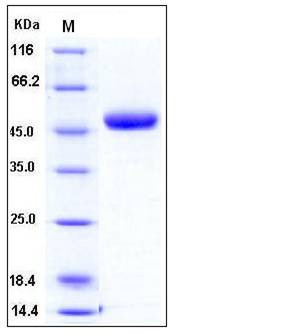| Catalog Number |
P11223-H08H |
| Organism Species |
Human |
| Host |
Human Cells |
| Synonyms |
CHI3,CHIT,CHITD |
| Molecular Weight |
The recombinant human CHIT1 consists of 456 amino acids after removal of the signal peptide and has a predicted molecular mass of 50.8 kDa. In SDS-PAGE under reducing conditions, the apparent molecular mass of rh CHIT1 is approximately 48 kDa. |
| predicted N |
Ala 22 |
| SDS-PAGE |
 |
| Purity |
> 94 % as determined by SDS-PAGE |
| Protein Construction |
A DNA sequence encoding the human CHIT1 (NP_003456.1) (Met 1-Asn 466) precursor was fused with a polyhistidine tag at the C-terminus. |
| Bio-activity |
|
| Research Area |
Immunology |Inflammation / Inflammatory Mediator |Lysosomal Enzymes |
| Formulation |
Lyophilized from sterile 1 |
| Background |
Chitotriosidase, also known as Chitinase-1 and CHIT1, is a member of the glycosyl hydrolase 18 family and Chitinase class II subfamily. It is a member of the mammalian chitinase family, structurally homologous to chitinases from other species, is synthesized and secreted by specifically activated macrophages. Chitotriosidase is a polymer of N-acetylglucosamine. Serum and plasma chitotriosidase activity is usually measured as the first step in diagnosis of Gaucher disease. Monitoring chitotriosidase activity is widely used during treatment of this pathology by enzyme replacement therapy. Its elevated plasma level reflects gradual intralysosomal accumulation in Gaucher cells (lipid-loaded macrophages). Macrophages overloaded by the enzyme accumulated in lysosomal material (lipids) were shown to secrete chitotriosidase; its increased expression was noted in several lysosomal storage diseases and atherosclerosis. In addition to lipid storage disorders, where Chit activity has longer been used as a marker of disease activity and therapeutic response, elevation of plasma Chit may occur in hematological disorders with storage of erythrocyte membrane breakdown products as thalassemia and different systemic infectious diseases sustained by fungi and other pathogens. Recently, increased Chit activity was demonstrated in CNS from patients with different neurological disorders. Chitotriosidase is believed to play a role in mechanisms of immunity and protection against chitin-containing pathogens. |
| Reference |
Barone R, et al. (2007) Plasma chitotriosidase in health and pathology. Clin Lab. 53(5-6): 321-33.Bargagli E, et al. (2008) Human chitotriosidase: a potential new marker of sarcoidosis severity. Respiration. 76(2): 234-8.Korolenko TA, et al. (2010) Chitotriosidase of human macrophages and mammalian chitinases: biological functions and abnormalities in pathology. Vestn Ross Akad Med Nauk. (11): 39-45. |

